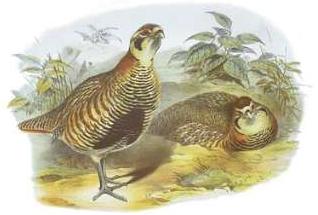Tibetan Partridge (Perdix hodgsoniae) - Wiki Tibetan Partridge
From Wikipedia, the free encyclopedia
[Photo] Perdix hodgsoniae - Tibetan partridge. Drawing by John Gould (1804-1881)
The Tibetan Partridge Perdix hodgsoniae is a gamebird in the pheasant family Phasianidae of the order Galliformes, gallinaceous birds.
This partridge breeds on the Tibetan plateau in Tibet itself, Northern Pakistan via Kashmir onto northwestern Indian, northern parts of Nepal, Sikkim and Bhutan, and western China.
It is found on mountain slopes and high meadows with some Rhododendron bushes, dwarf Juniper or other scrubs for cover, typically between 3,600 - 4,250 m (11,800 ??? 14,000 ft). It is a non-migratory terrestrial species, but moves downhill to high desert plains in winter, and may ascend to the snowline in summer
The nest is a grass-lined depression next to a boulder or scrub, and the typical clutch is 8-10 brownish-buff eggs. The Tibetan Partridge forms flocks of 10-15 birds outside the breeding season, which tend to run rather than fly. When disturbed sufficiently, like most of the gamebirds it flies a short distance on rounded wings, the flock scattering noisily in all directions before gliding downhill to regroup.
It is some what difference in appearance from the other Perdix species, the Grey and Daurian Partridges. It is 28-31 cm long, and shares its brown back, blackish belly patch and chestnut flanks with its relatives, but has a striking black and white face pattern, which contrats with the rufous nape. The breast and flanks are white, heavily barred with black and chestnut, and the lower belly is white. Despite its striking appearance, the head and breastpattern provide good cryptic camouflage in its rocky habitat.
The female is similar to the male but duller, and the juvenile is a featureless buff-brown, lacking the distinctive facial and underpart markings of the adult. There are three subspecies differing mainly in the plumage becoming darker further east.
The male’s song, usually given from a boulder, is a rattling scherrrrreck- scherrrrreck , and the flight call is a shrill chee chee chee.
This is a seed-eating species, but the young in particular take insects as an essential protein supply.
Tibetan Partridge is not globally threatened, and seems secure in its extensive and often inaccessible range on the Tibetan plateau.
The scientific name commemorates English civil servant, ethnologist and naturalist Brian Houghton Hodgson
http://en.wikipedia.org/wiki/Tibetan_Partridge
| The text in this page is based on the copyrighted Wikipedia article shown in above URL. It is used under the GNU Free Documentation License. You may redistribute it, verbatim or modified, providing that you comply with the terms of the GFDL. |
